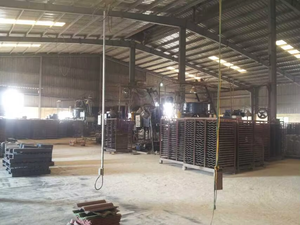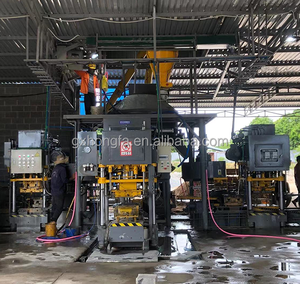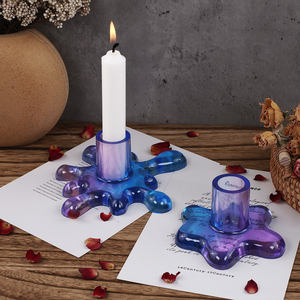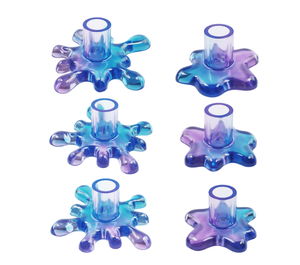
All categories
Featured selections
Trade Assurance
Buyer Central
Help Center
Get the app
Become a supplier

(8962 products available)






































A flow mold is a tool or device used to shape materials as they flow into it. Different types of flow mold are used in manufacturing industries to create products with specific shapes and designs. They vary in construction and application. Some are made of metal, while others use polymer materials. They differ in how they are used and the products they create. Below are some of the various types of flow molds:
Silicone flow mold
This silicone mold is flexible, resilient, and can withstand high temperatures. It is often used to make food, such as chocolates, cakes, or jellies. The silicone material makes it easy to remove the finished product without damaging it.
Polymer flow mold
These molds are made from polymers. They are light and cost-effective. They are mainly used in the jewelry industry to make rings and other ornaments. They can create complex designs that are exact replicas of the original.
Metal flow mold
Metal molds are durable and can withstand high pressure and temperature. They are commonly used for casting metals and making machine parts. They have a high initial cost but can be used for a long time due to their longevity.
3D printed flow mold
This is a new type of mold created using a 3D printer. It allows for rapid prototyping and testing of new mold designs. It is also used to create complex shapes that are difficult to make with traditional molding methods.
Glass flow mold
Molds made from glass are often transparent. They are used in processes that require the operator to see the material flowing inside the mold, such as in some types of injection molding. They are also used in experimental setups in laboratories.
Ceramic flow mold
These are high-temperature ceramic molds used for processes like investment casting. They are used to make complex metal parts in the aerospace or automotive industries.
Designing a flow mold requires careful consideration of various factors to ensure optimal functionality and performance. One of the key aspects is selecting the right material for the flow mold. Typically, durable materials such as stainless steel or aluminum alloys are used to withstand high temperatures and pressures during the molding process. These materials also provide resistance to corrosion and wear, thus extending the lifespan of the mold.
Another crucial factor in designing a flow mold is determining its size and shape. The dimensions of the mold should be compatible with the desired product's specifications, while its shape must facilitate proper flow of the molten material into all cavities. Additionally, incorporating features like vents and gates helps in controlling the flow of the material within the mold, ensuring uniform filling and reducing cycle time.
Moreover, designing a flow mold involves creating intricate patterns and textures on its surface to impart desired characteristics onto the final product. This can include things like logos, brand names, or specific design elements that are important for the appearance or functionality of the molded item. Utilizing computer-aided design (CAD) software greatly aids in creating these complex patterns with precision.
In summary, designing a flow mold necessitates careful consideration of material selection, size and shape determination, as well as pattern creation using advanced technologies. By addressing these aspects, a flow mold can be created that meets all requirements efficiently and effectively, resulting in high-quality molded products.
Industrial Applications:
Flow molds are widely used in industries such as automotive, aerospace, and consumer goods. These molds enable the production of complex parts with precise features, such as intricate gear systems, lightweight structural components, or ergonomic handles for everyday products.
Medical Industry:
In the medical field, flow molds facilitate the manufacturing of complex and precise devices, like surgical tools, implantable devices, and diagnostic equipment. The consistent quality and exact replication achieved through flow molding are crucial for the safety and effectiveness of medical products.
Electronics and Technology:
With the increasing demand for compact and intricate electronic devices, flow molding plays a vital role in the electronics industry. It enables the production of complex components, such as connectors, housings, and intricate circuit boards, with high precision and miniaturization. This process allows for better performance and functionality in devices like smartphones, laptops, and wearable technology.
Consumer Goods:
Flow molds are employed in the production of various consumer goods, including household appliances, sporting equipment, and personal care products. The ability to create complex designs and textures enhances the aesthetics and functionality of these everyday items, improving the overall user experience.
Packaging Industry:
In the packaging sector, flow molds are utilized to produce intricate and appealing packaging designs. These molds enable the creation of complex shapes, such as custom bottle designs, unique food containers, and protective packaging for delicate electronics. Packaging flow molds enhance product presentation and protect and preserve products during transportation and storage.
Construction and Infrastructure:
Flow molds are employed in the construction industry for producing complex architectural elements, structural components, and infrastructure parts. This application enables the creation of intricate designs, such as decorative moldings, custom doors and windows, and precast concrete elements for building projects. It enhances the design possibilities and construction efficiency in the construction industry.
Research and Development:
Flow molds are also used in research and development settings, where prototyping and testing are essential. Engineers and designers can quickly create prototypes of new concepts, test them for performance, and make necessary adjustments. This application of flow molds accelerates the innovation process and reduces the time and costs associated with traditional prototyping methods.
Several factors should be considered when selecting a suitable flow mold for specific needs. These factors are mold material, product design, number of parts, production rate, and cost. Before choosing a flow mold, looking at these factors is essential.
Mold material
Choosing the right material for the flow mold is important. Metals like aluminum or steel can be used. They are durable and can last long. Sometimes, lighter materials like fiberglass are used. They are cheaper and still work well. The choice of material depends on how many copies are needed and the budget.
Product design
The final product's design significantly impacts the flow mold selection. Complex shapes may require molds that allow for precise material flow to avoid defects. Consider features like undercuts, intricate details, and the desired surface finish. The design must facilitate the easy release of the finished product from the mold without causing damage.
Number of parts
The number of parts that need to be made also affects the kind of flow mold chosen. For fewer parts, simple and flexible molds are used. But, if many parts are needed, more durable and cost-effective molds are selected for mass production.
Production rate
The production rate influences the choice of flow mold. High production rates often necessitate molds with excellent heat transfer properties and durable materials. This reduces cycle times and extends mold life. Lower production rates can afford more complex molds with finer details.
Cost
The overall cost is always considered. This includes the initial cost of the flow mold and the long-term costs of maintenance and production. It's important to find a balance between quality and expense to ensure the project stays within budget.
Q1: How can one extend the mold's life?
A1: The best way to extend a flow mold's life is to take care of it. Clean the mold after every use and store it properly. Also, inspect the mold regularly for damage and get it repaired before it worsens.
Q2: How can one improve the molding process?
A2: To improve the molding process, one should optimize the material's temperature and viscosity. Using the right molding powder and adding more of it can also help. Ensure that the mold is clean and well-maintained to make the flow easier.
Q3: What are the safety precautions for using flow molds?
A3: When using a flow mold, be careful with hot liquids or materials. Use gloves and goggles to protect oneself. Be careful not to spill anything, as it can cause burns or make the floor slippery.